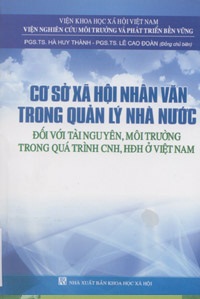 |
Since the late decades of the 20th century, the issue of environment and environmental protection has become burning and urgent in the early 21st century: exhaustion of natural resources and environmental change have become great disasters that overwhelm the existence and development of humankind, broken ozone, greenhouse effect, increased temperature for glacial burst, raised seawater submerging many lands; toxic wastes that pollute the environment as well as increased difficult-to-cure diseases are leading the humankind to a gloomy destruction process. In fact, the humankind, by revolutions in the production method, in the socioeconomic structure, pushed the society to surpass one civilization wave to another civilization wave and created strong production forces, which makes the human think that they are conquering the nature and governing the world. However, at the same time, during such process, the human, at certain levels, destroyed necessary foundations, scenes and environments for their life and development.
How could the humankind have overcome such dramatic reality? At first, the researchers rang warning bells on the risk of pollution and damage to the environment caused by the development. Then, the United Nations (UN) joined and the environmental protection was not limited to the perception because its nature is action. Under the leadership of the global sustainable development program put forth by the UN, the countries made commitments and specific action plans to protect the environment. The states at various levels have become the general subject in the environmental protection and understand that natural resources and environment are entities and natural process. Some natural laws are also the entities, the processes with scope and scale exceeding the activities and personal consumption of the people or a certain community. On the other hand, they are entities that are always the foundations of the human life and participation at various levels in the socioeconomic development process. Due to such two-faced characteristics, the environment is often the external process, i.e. lying outside the impact and regulation of the market mechanism and this is an issue that should be invested and researched thoroughly and systematically.
Starting from the above practical basis, in December 2008, with the permission of Vietnam Environment and Sustainable Development Institute (Vietnam Academy of Social Sciences), Assoc. Prof. Dr. Ha Huy Thanh, Assoc. Prof. Dr. Le Cao Doan act as the co-chief editors of the book entitled “Humanity social basis in the State management for the natural resources and environment in the industrialization and modernization in Vietnam”.
The book includes 4 chapters:
Chapter 1: Relationship between the people, society and nature in the socioeconomic development.
Chapter 2: Market economy and the State in the management of natural resources and environment.
Chapter 3: Social, cultural basis and human factor in the State management for the natural resources and environment in the industrialization and modernization in Vietnam.
Chapter 4: State management model for the natural resources and environment in the promotion of industrialization, modernization and international integration.
The information in the above contents affirms that the theoretical point of socioeconomic development always complies with the socioeconomic laws and principles. At the same time, such development creates an artificial environment beside and inside the natural environment, forming a natural - artificial environment or a natural - social environment. The environment of this kind is always changing with the socioeconomic development. They combine and interact to create a mixed environment. The fact that the degradation and crisis of natural environment well as social environment fail to adapt to the requirement of the modern development have placed the management and administration of environment into the State. Importantly, for some typical management objects, i.e. mixed living environment, on which basis does the State rely to manage the environmental development. Obviously, for such complicated management object and with a new function regulated by the modern development process, the environmental management by the State cannot stay at the traditional management method. By analyzing, pointing out connections and interaction laws between the nature and the society, the authors of this book hope that it will contribute to putting forth the most fundamental basis for the environmental management by the State in the modern socioeconomic development both in content and in format.
Hopefully, this book will become a useful material for many readers, especially those doing jobs related to the social management in general and environmental management in particular.
Pham Vinh Ha







